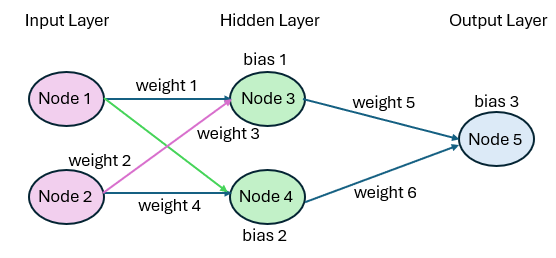An artificial neural network (ANN) is a collection of nodes (neurons) that are connected to mimic the functions of neurons in the brain. These networks are used to solve various artificial intelligence (AI) problems, including predictive modeling and pattern recognition. A key difference between a neural network and other mathematical constructs is the way the neural network learns to solve problems.
Figure 1 displays a simple neural network.
Figure 1 – Simple neural network
This neural network consists of three layers. Each layer consists of one or more nodes. The left-most layer is the Input Layer and consists of two nodes (Node 1 and Node 2). The right-most layer is the Output Layer and consists of one node (Node 5), although the Output Layer may contain more than one node. The middle layer, called the Hidden Layer, contains two nodes (Node 3 and Node 4). A neural network contains one Input Layer, one Output Layer, and any number of Hidden layers.
Topics
- Basic Concepts
- Training and Backward Propagation
- Training and Testing Methodology
- Simple Example (using an Excel spreadsheet)
- Real Statistics Data Analysis Tools
- Another Excel Example
- Recognizing Digits Example
References
Lubick, K. (2022) Training a neural network in a spreadsheet
https://www.youtube.com/watch?v=fjfZZ6S1ad4
https://www.youtube.com/watch?v=1zwnPt73pow
Nielson, M. (2019) Neural networks and deep learning
http://neuralnetworksanddeeplearning.com/
